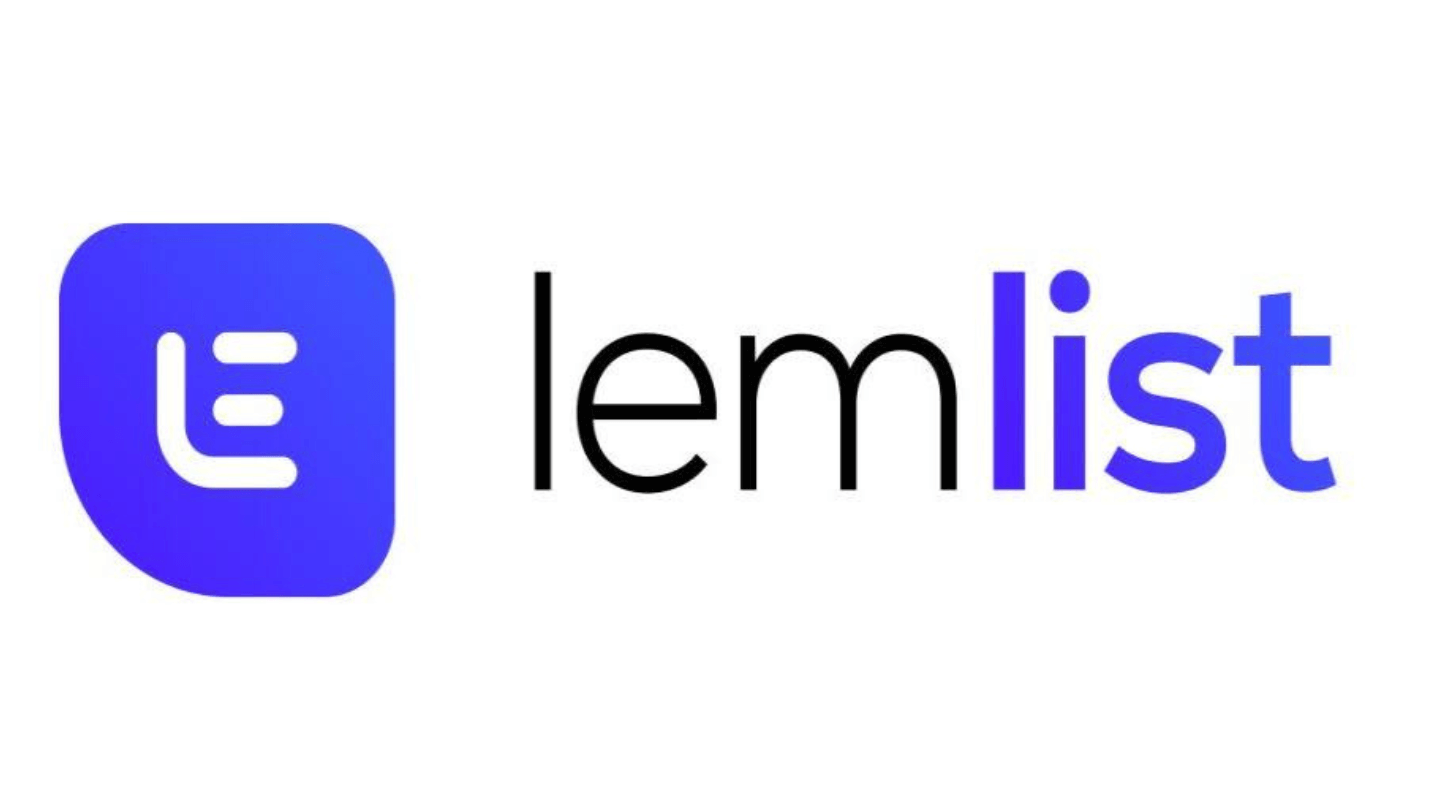“You only get one chance to make a good first impression.
A recent Hubspot study shows that 8 out of 10 prospects would prefer to talk to sales representatives via email, rather than through any other medium. Email is a fundamental sales channel, and it’s here to stay.
In this article, we review all the best practices in B2B email prospecting.
Sommaire
1. It’s all about the quality of your cold mailing file
A good prospecting file will always be the keystone of a successful prospecting campaign. Here are some elements to validate that your file is of good quality.
The disability rate of emails
If you have too many invalid emails, your mailings will not pass the most aggressive spam filters at the beginning of the campaign.
Your open rates will remain poor (below 80%), and in the worst cases, your reputation with ISPs (and your SMTP relay) will decline, until you have serious deliverability problems.
Getting out of it will take a lot of energy.
It is the nightmare of a failed campaign.
In real life, a prospecting file with a high invalidity rate will almost always be a file that is too old. If you can’t trust the email data point, don’t trust the other points either (First Name, Company, Post Office, etc.)
To assess the quality of your file, use an email list cleaning tool such as datavalidation before starting your campaign.
The number of customisation elements
Personalization is a fundamental element for successful prospecting campaigns. It has even become a bit of an obligation with the RGPD, which requires a legitimate reason to contact someone without their consent by email (in b2b).
But to personalise your marketing emails, you need material, elements to re-use in your emails.
This is where a good prospecting file makes all the difference.
If you have, for example, your prospect’s start date, you can tailor your message to congratulate all those who have recently taken up their post.
You might even decide to target only these initially if the conversion rates are better.
Salesdorado’s advice
If your file is a little light, don’t hesitate to look at B2B data enrichment tools. We like dropcontact at Salesdorado for the French market.
As you will have understood, prospecting by email allows you to save time compared to cold calling, but it does not allow you to skip the qualification stage.
On the contrary, the more you automate your sales processes, the more fundamental your qualification becomes
2. The subject of your email is worth 40% of your email
Forget about saying “You shouldn’t judge a book by its cover”. In real life, that’s exactly what we all do, all the time.
On average, a person receives 120 e-mails per day.
In a fairly serious study, Constant Contact (the pre-Machimp Mailchimp in the US) determined that 47% of emails are opened or ignored based solely on their subject line.
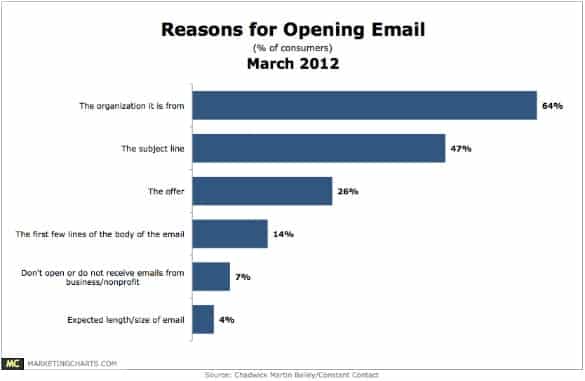
When creating your cold mailing campaign, we advise you to spend 40% of your time writing the subject line.
Salesdorado’s advice
The best thing is to do A/B tests regularly with different objects to see which ones work best. Most email prospecting tools such as Woodpecker or Reply.io to automate the sending of your emailings (and your reminders)
You can find ideas for email objects here and here. Some tips for the road:
- Keep itsimple: be clear and concise. Being original is good, but it’s dangerous.
- Be transparent: It’s not called an object for nothing… Be honest, you’ll win
- Personalise: Personalization also applies to the subject line of your email.
- Abuse the referral: According to Sales Insights Labs, less than 19% of salespeople systematically ask for a referral. Yet Linkedin allows you to identify a common relationship with a prospect in three clicks, and referrals are an extremely powerful lever. Abuse it!
- Don’t over-optimise the opening: make sure you monitor the only KPI that really counts: the positive response rate. Too little experimentation could lead you astray, especially if you do A/B tests focusing on a single KPI.
We won’t go into detail here, but also take care of your “sender”. Make sure you are easily identifiable, and avoid anonymous and generic sender names such as “Salesdorado” or “The Salesdorado team”. An email is a personal communication, sent by one person with a first & last name to another. In the same Constant Contact study, this is even the number one factor in the decision to open an email or not.
If your name is less telling than your brand, you can use ready-made formulas such as “Axel @ Salesdorado” or “Axel de Salesdorado”.
3. Pay attention to your timing
The timing of your emailings can influence the opening rates of your emailings. It is customary to send emails at times when people are sitting at their desks or checking them at the end of the day, i.e. between 7am and 10am, and then again at around 4pm, the recipient’s local time.
The problem is that everyone knows this information, and competition can be tough in these time slots. The best practice is to test to find the best timing. This is not difficult with the analysis tools we have.
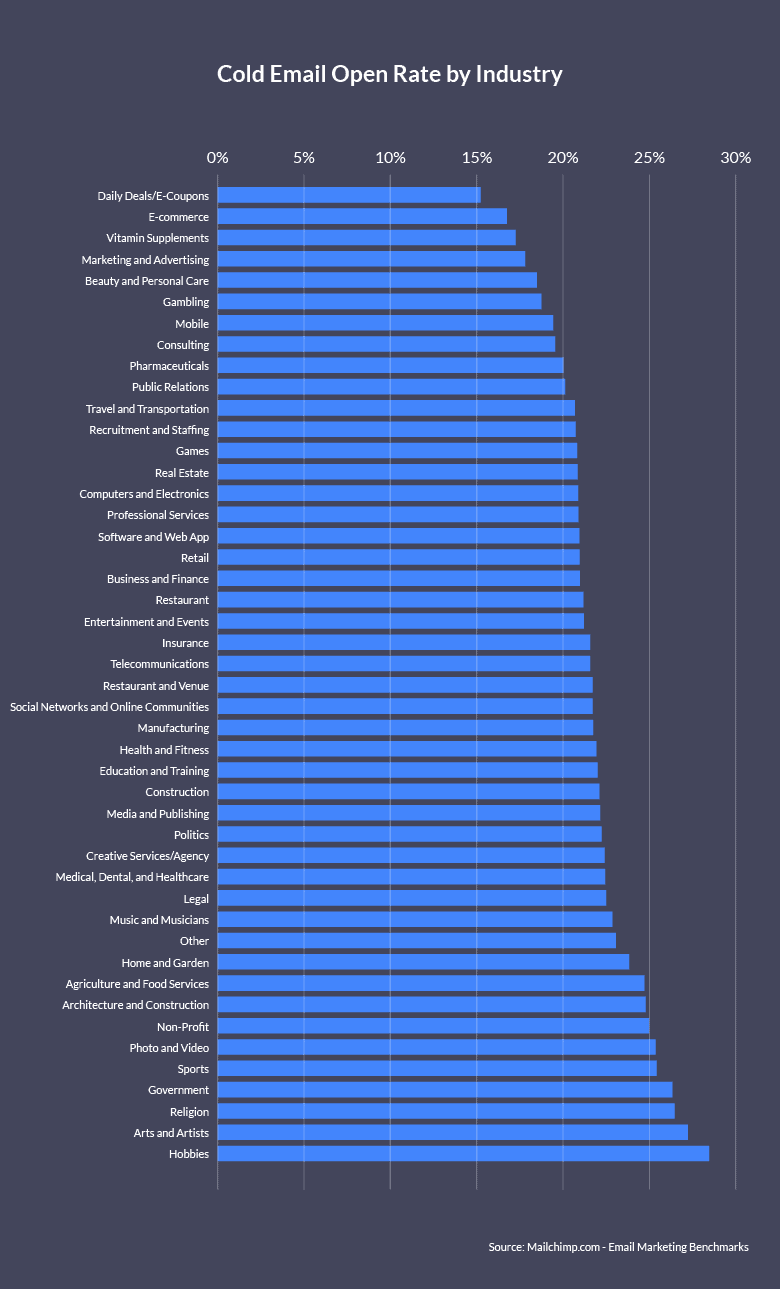
The day of the week is also important for sending your cold mails. Mondays are almost always the worst days to reach customers. It’s the effect of the weekend, schedules etc. Aim for Tuesday – Thursday to be very targeted.
4. Copy the others
“Good artists copy. Great artists steal” – Pablo Picasso
If the subject line is important to create interest, the content is also very important. Spend a lot of time personalising your content, with THE right call-to-action (only one), the right length (5 lines, including signature). Note that the average click-through rate is almost 4 times higher when the email is personalised.
The following is a guideline for planning the time you need to spend on the key elements of unsolicited email:
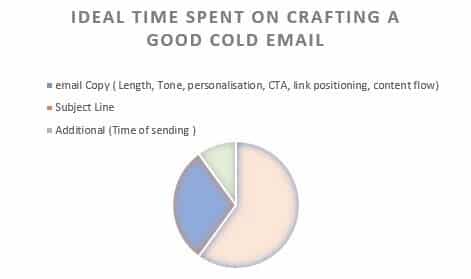
If you want to work seriously on your cold emailings, pay attention to the emails you receive, and follow all the software that talks about email prospecting in any way. Resources like TheSalesGame, or Lemlist’s blog are full of examples and best practices. We’ve also published an article with some examples of prospecting emails, and some concrete tips for getting a response to your prospecting emails on Salesdorado.
5. Some tips for the body of your cold mailing campaigns
Cold emails help break the ice with prospects and introduce a slight degree of familiarity.
Here are some good practices for organising your mailings:
The 1st email:
If you are sending a first ever cold mail to a potential customer, the person is likely to be at the top of the funnel. At this stage, the purpose of your email should be to familiarise the person with your brand name, you or both.
Here are some key points to consider for the first email:
- ALWAYS personalise! Avoid sending an email saying “Hello Sir”. A recommendation from a mutual acquaintance is a very powerful element in forcing interest.
- Introduce yourself – Before you start talking about your proposal, tell them who you are, and it will make you more likeable. For example, always start with “I’m Martin and I run marketing at Sendinblue” – in an instant the recipient of the email knows who you are and what you do. If you haven’t got a recommendation, find a common link, such as a friend, a group or a conference you both attended.
- Express to the recipient your ability to solve a problem without saying too much so that they can easily
- Have a Call-To-Action – at this stage your request should be in line with the state of your relationship with the prospect. Keep it light. Give more than you ask. For example, you can share a white paper or blog post, and ask a concrete question about the content you shared.
- Keep it short and simple. The shortest emails always get much higher response rates. The ideal length of a sales email would be between 50 and 125 words… And that’s already long in my opinion 🙂
Dunning
Now, let’s say that for some reason your first email did not get a response. Don’t be discouraged and be creative in getting a response.
The objective is to have respectable gaps between emails. I would recommend a minimum of 4 to 5 reminders after the first email with a minimum interval of 2 days between 2 consecutive mailings.
Woodpecker’s results suggest thatemail campaigns containing 4-7 emails in a sequence have a response rate three times higher (27%) than campaigns containing only 1-3 emails. It is important to know if your emails are being read. If they are not, you can try contacting your prospects via other channels.
Here is a best practice example from Steli Efti, founder of close.io:

Another key point to remember here is clarity of purpose. What do you want to get out of your follow-up emails (e.g. an appointment, a white paper download, a video viewing, a registration, etc.). Here are some things to look out for in your follow-up:
First dunning email
- Don’t send a new email, but sequence it with the previous one (you’d be surprised but many still don’t realise this mistake). Most email sequence automation tools allow you to do this automatically.
- Add context and remind them that you have already sent an email. For example:
- End your email neatly. Humanising the content of your email will result in a better response rate.
- Always have a call-to-action. Even if the recipient has not responded to previous e-mails, it is essential to add another call-to-action. The action to be taken after reading the email should be very clear to the reader.
- Automate your follow-ups. It is important to personalise your cold emailings, especially the first one. But we’re human, and no one has the discipline to send 7 follow-ups at fixed intervals. Automating your follow-ups (which are much lighter emails) will ensure that they are sent at the right time, and will allow you to optimise the time between each email.
For the 3rd and 4th email reminder – Email reminder
If you still haven’t received a response, it means either that the prospect is unavailable (for whatever reason) or that they are difficult to motivate.
To get a response, you will now need to get creative with your email content. This is a good time to get back into the swing of things manually.


However, be careful, what these statistics forget to measure is the positive response rate. It is quite easy to understand why after 5 emails without any response, some prospects are suddenly motivated to respond, to ask you to leave them alone…
To help you identify which prospects to follow up, you can, for example, filter out prospects who have not opened any of your emails. On the face of it, your proposal does not interest them. No need to insist.
Patience and persistence are the key to recovery. It is important that you sound confident and humble at the same time in your emails. Here are some suggestions for working on the content of your follow-up emails:
1. Add social proof :
The prospect doesn’t know you, he has no reason to trust you (I’ll stop insisting on the recommendation…). You have to go deeper and get their trust by adding social proof. Some examples:
- This customer (preferably a competitor or an easily identifiable brand) says that about us.
- Our {protester’s location or sector} community says this and this about our product (with links to each)
- Such a comparison of {third party market reference source} has just come out, I thought you might be interested!
2. Get noticed.
We’re getting into multi-channel prospecting, which is getting a lot of press these days. We’ve written about it everywhere on Salesdorado, but I’ll write it again here: Adding a channel to your processes means multiplying the complexity of the process. If you are validating the validity of your emails, forget it right now.
You can only reasonably add a channel once you have a well-tested process in place, and you shouldn’t expect to get the moon because you’ve taken a £400 course from a guru who has never written an email by hand.
However, in your prospecting, you will be confronted with leads that simply do not process cold emails. And in this case, contacting them on linkedin, on the phone, or in a slightly more inventive way, can be interesting.
We also discuss a method for creating more proximity with your prospects. Even though, once again, a recommendation is much easier to obtain, and much more effective.
6. Cold call 2.0.
Cold calling 2.0 is a technique developed by Aaron Ross when he was at Salesforce (in 2011… for context). The technique reportedly helped Salesforce generate $100 million in revenue, the core principle being “making cold calls without cold calls“.
Cold calling 2.0 is a systematised lead generation process in which you create internal references in the prospect’s company before contacting them directly.
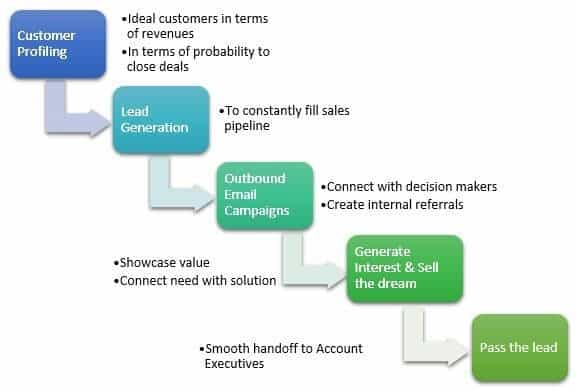
The good news is that this method also works for cold mails!
For example, a manager from a recruitment agency contacts you on LinkedIn, and sends this email after he has given you his email address.
Her goal was to reach the HR manager of the startup through her. At this stage, when the marketing employee puts the person in touch with HR, all he needs to tell the HR manager is that the marketing person referred him to her. This breaks the ice and gives the illusion that the person is an acquaintance in the reader’s mind.
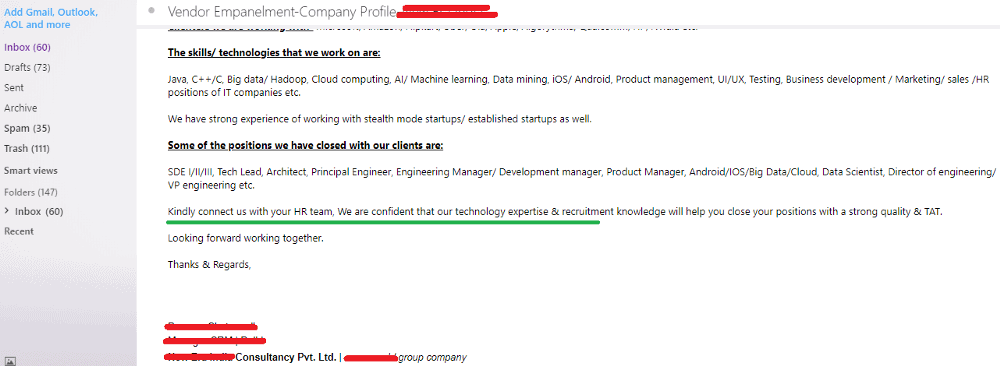
7. Content of a cold mailing – best practices
- Humility – Use a humble tone, not an insolent or loud one. Humility is a virtue even in sales.
- Confidence – A confident tone reflects confidence in your product offering as well as an insightful mind.
Data and facts – Meaningful numbers will always trump abstract talk. Just don’t overdo it. - Don’t be pushy in selling – Salespeople have an image of being pushy. People are tired of this attitude, so it is important to give the impression that you are not a salesman desperate to sell your product. Be polite, not pushy.
- Don’t spam – Don’t spam prospects if they have disengaged from your prospecting emails or offer. Bombarding them with regular emails or calls when they are not interested could simply irritate them and expose you to bad press or negative word of mouth.
- Personalise your emails – Always personalise your emails to get a better response rate.
- Consistency – Be consistent in your canvassing. Don’t send follow-up emails weeks after the first one, etc. Also, be consistent in what you are trying to achieve and what you are offering.
In conclusion
Cold emailing can work!
Email is nothing more or less than a virtual interaction and always works when it is well designed. The more time you spend building a list of prospects and tailoring your message to that list, the better the conversion rates will be.
Remember that this is all about breaking the ice and building the basis for human interaction in the coming days. Your cold email should inspire confidence, calm, humility, contain figures, etc. Always know the objective of your campaign and the relevance of your reach to your prospect’s position in the sales funnel (top, middle or bottom).
Finally, always have a call-to-action in your cold mail and monitor its statistics (opening rate, opening time, etc.).




